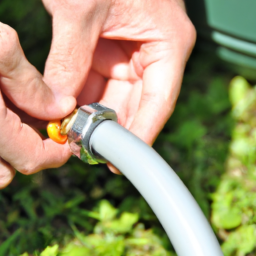Removing Garden Hose How-To Guide for Spigot
How To Remove Garden Hose From Spigot
Humans - especially DIY homeowners - have learned through trial and error the hard way: mild garden tools may not be enough to pry open a stubborn spigot-hose bond, and brute force can lead to costly repairs. In this article, we'll provide you with the correct techniques to remove a garden hose from a spigot. Introducing the right steps and tools can help preserve both (1) the garden hose as well as (2) the spigot, ensuring they both serve your outdoor living space needs for years to come.
Must-Have Tools and Supplies
Before giving the spigot-hose bond a tug, let's review the materials you'll need to remove the hose safety and effectively:
- Gloves (for protection)
- Wrench(es)
- Vise-grips (locking pliers)
- WD-40
- Towel (or rag)
Instructions Step-by-Step
We'll commence with the 6 key steps to remove a garden hose from a spigot:
1. Prepare and Wet the Area
To begin with, make sure the area around the spigot-hose bond is clean and clear. Next, spray the bond with WD-40 and evenly moisten the area for a few seconds.
2. Remove Any Couplers or Caps
Once the area is prepped, use the wrenches to carefully loosen the couplers (or caps) and break the bond.
3. Shutoff the Water Supply
If the water is still running, locate the water-supply switch and shut off the water to the spigot.
4. Activate a Sure Grip
Now, slip on your gloves and grip the hose reels with the vise-grips. Do this twice, if need be, to ensure a tight connection.
5. Angle Away From the Spigot
While maintaining your grip, slowly pull away from the spigot at an angle. If necessary, use a towel or rag to protect the hose from surface damage.
6. Disconnect and Test
Once the garden hose is disconnected, test the water pressure and check the spigot for any damage.
Brief Recap
Removing a garden hose from a spigot doesn't have to be a trial-and-error game. Follow the instructions we outlined to help keep both the hose & the spigot functioning well for many years. Be sure to always shut off the water supply, equip yourself with the right tools & supplies, and safely angle your pulls away from the spigot to detach garden hoses with ease.
Looking Ahead
Taking a few preventative steps can also help make future garden hose removal simpler. Establish a preventive maintenance routine to inspect the hose for wear & tear (e.g., kinks, fraying, etc.). Additionally, adding a few drops of petroleum jelly to the spigot-hose bond or applying a few layers of Teflon tape can help make the attachment smoother and easier to detach.

Previous Page
Next Page
